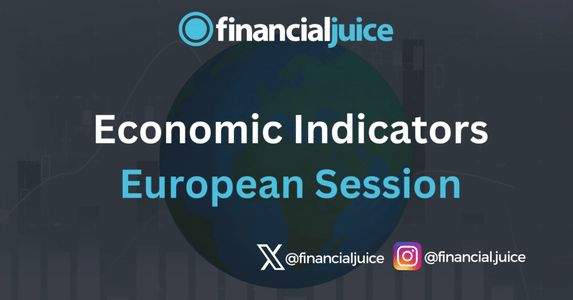
Week Ahead: Economic Indicators (EU)
Hey, Traders!
For the June 3rd week, here is a list of all of the major economic indicators being released during the EU Session, with a brief synopsis of what they represent and what to possibly expect from the markets in reaction.
Monday 3rd June
03:50 – 04:30 ET
Manufacturing PMI (France, Germany, Eurozone, UK)
The Manufacturing Purchasing Managers’ Index (PMI) measures the activity level of purchasing managers in the manufacturing sector. A reading above 50 indicates expansion in the sector; below 50 indicates contraction. Traders watch these surveys closely as purchasing managers usually have early access to data about their company’s performance, which can be a leading indicator of overall economic performance.
What to expect:
A higher than expected reading should be taken as positive/bullish for the GBP, while a lower than expected reading should be taken as negative/bearish for the GBP.
Tuesday 4th June
02:30 ET
Swiss CPI
CPI an average measure of the level of the prices of goods and services bought for the purpose of consumption by Swiss households. Monthly and annual changes in the CPI provide widely used measures of inflation. The policy target measure for the Swiss National Bank (SNB), the annual CPI rate can be distorted by swings in prices amongst the more volatile subsectors and the CPI excluding fresh food and energy is used as a better guide to underlying short-term trends. Although not a member of the Eurozone, a harmonized index of consumer prices (HICP), measured according to Eurostat’s procedures, is also published alongside the CPI.
What to expect:
The consumer price index is the most widely followed indicator of inflation. An investor who understands how inflation influences the markets will benefit over those investors that do not understand the impact. Inflation is an increase in the overall prices of goods and services. The relationship between inflation and interest rates is the key to understanding how indicators such as the CPI influence the markets- and your investments. Inflation (along with various risks) basically explains how interest rates are set on everything from loans to notes and bonds.
03:55 ET
German Unemployment Rate
The unemployment rate is calculated by the Federal Employment Agency based on the number of unemployed persons as a percentage of the number of all civilian members of the labour force (dependant civilian employed persons, the self-employed family workers and unemployed). Unemployed is defined as persons between the ages of 15 and 65 and who are without employment or only with short-time employment (currently less than 15 hours per week) and seeking employment of at least 15 hours per week subject to compulsory insurance.
What to expect:
Unlike in the U.S. no wage data are included in this report. But by tracking the jobs data, investors can sense the degree of tightness in the job market. If labor markets are tight, investors will be alert to possible inflationary pressures that could exist. If wage inflation threatens, it’s a good bet that interest rates will rise; bond and stock prices will fall. No doubt that the only investors in a good mood will be the ones who watched the employment report and adjusted their portfolios to anticipate these events. In contrast, when job growth is slow or negative, then interest rates are likely to decline – boosting up bond and stock prices in the process.
German Unemployment Rate
The Unemployment Change released by the Bundesagentur für Arbeit and published by the German Statistics Office is a measure of the absolute change in the number of unemployed people in Germany using seasonally adjusted data.
What to expect:
A rise in this indicator has negative implications for consumer spending, as there’s less people working and therefore diminishes economic growth in the country. Generally, a reading above expected is seen as negative (or bearish) for the EUR, while a low reading is seen as positive (or bullish).
Wednesday 5th June
03:55 – 04:30 ET
Services and Composite PMI
Services:
The Services Purchasing Managers’ Index (PMI) provides an estimate of service sector business activity for the preceding month by using information obtained from a representative sector survey incorporating transport and communication, financial intermediation, business services, personal services, computing and IT and hotels and restaurants. Results are synthesised into a single index which can range between zero and 100.
Composite:
The Composite PMI Index measures the activity level of purchasing managers in both sectors (manufacturing and services).
What to expect:
A reading above (below) 50 signals rising (falling) activity versus the previous month and the closer to 100 (zero) the faster is activity growing (contracting).
Thursday 6th June
02:00 ET
German Industrial Orders
Manufacturers’ orders are a leading indicator for industrial production.
The figures are calculated every month by the Federal Statistical Office and represent the value of all orders for the delivery of self-made products confirmed by industrial enterprises with 50 or more employees in the respective reporting period.
The results are broken down by both sector and region of origin (domestic and foreign split into euro area and non-euro area). Monthly volatility can be very high, so moving averages give a much better guide to underlying trends.
What to expect:
Manufacturers’ orders data are keenly awaited by analysts each month. The data present a detailed breakdown by various sectors and a reading of the pulse of a major sector of the economy. Like the PPI, manufacturing orders data exclude construction, which is the preferred Eurostat measure.
A higher than expected reading should be taken as positive/bullish for the EUR, while a lower than expected reading should be taken as negative/bearish for the EUR.
Friday 7th June
02:00 ET
German Industrial Production
Industrial production measures the physical output of the nation’s factories, mines and utilities. Data are collected from companies in the sector with fifty or more employees and include mining and quarrying, manufacturing, energy and, in contrast to its Eurozone counterpart, construction.
Like the manufacturing orders data, the production index has the advantage of being available in a timely manner giving a more current view of business activity. Those responding to the data collection survey account for about 80 percent of total industrial production. Like the PPI and the orders data, construction is excluded.
What to expect:
This report has a big influence on market behavior. In any given month, one can see whether capital goods or consumer goods are growing more rapidly. Are manufacturers still producing construction supplies and other materials? This detailed report shows which sectors of the economy are growing and which are not.
05:00 ET
Eurozone GDP
Gross domestic product (GDP) is the broadest measure of aggregate economic activity and encompasses every sector of the economy. The flash estimate, released a relatively short 4-5 weeks after the end of the reference quarter, is an effort to speed up delivery of key economic data. In contrast to most European flash releases, the French version provides an early look at the GDP expenditure components.
What to expect:
Each financial market reacts differently to GDP data because of their focus. For example, equity market participants cheer healthy economic growth because it improves the corporate profit outlook while weak growth generally means anemic earnings. Equities generally drop on disappointing growth and climb on good growth prospects.
Bond or fixed income markets are contrarians. They prefer weak growth so that there is less of a chance of higher central bank interest rates and inflation. When GDP growth is poor or negative it indicates anaemic or negative economic activity. Bond prices will rise and interest rates will fall. When growth is positive and good, interest rates will be higher and bond prices lower. Currency traders prefer healthy growth and higher interest rates. Both lead to increased demand for a local currency. However, inflationary pressures put pressure on a currency regardless of growth.



